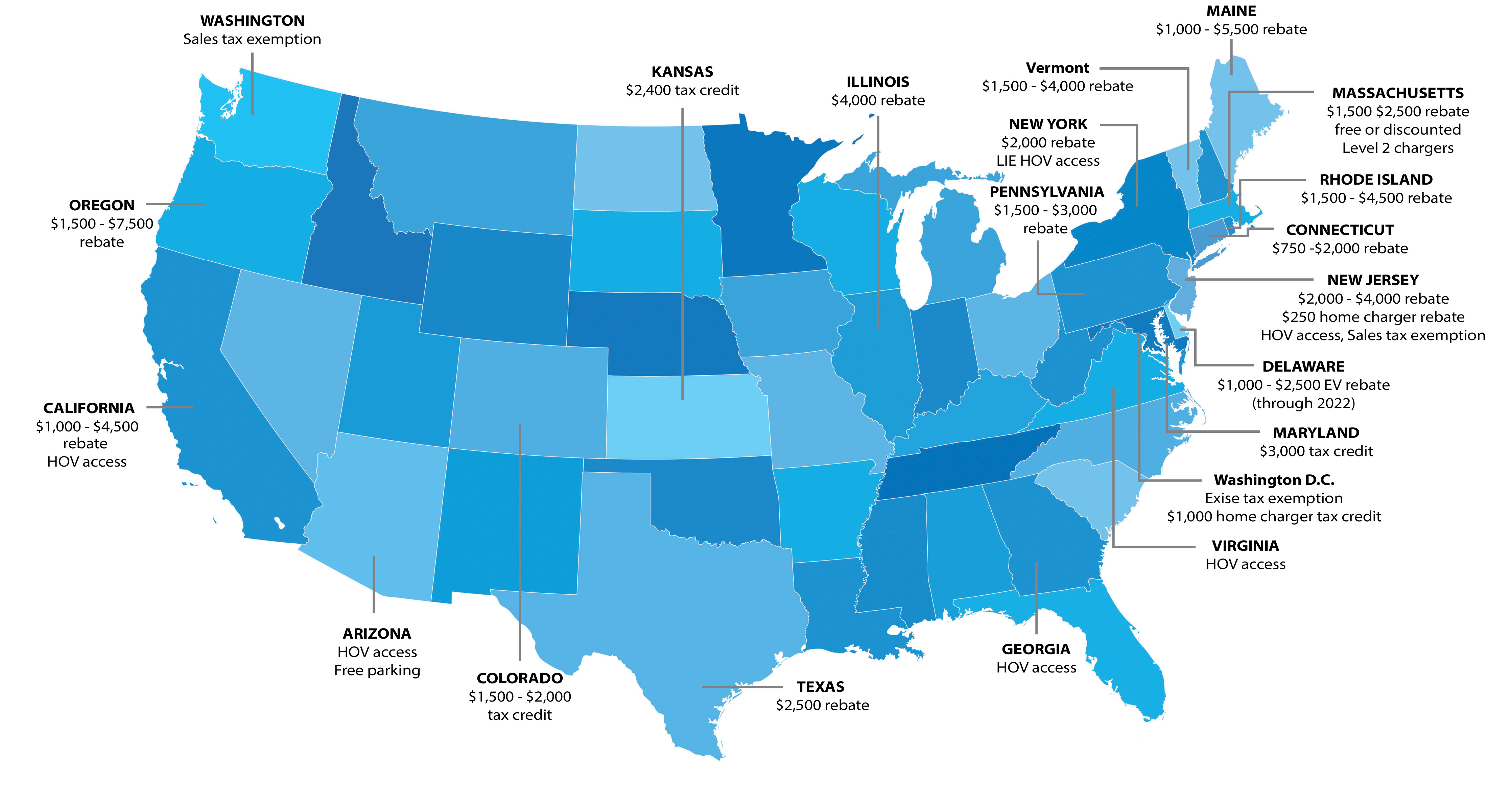Tax Credits and Rebates
2023 Federal Tax Credit Changes
With the passage of the Inflation Reduction Act, the US EV Federal Tax Credit
(called IRC 30D by the IRS) has changed. The Inflation Reduction Act officially
renamed the credit the “Clean Vehicle Credit.” Previously, the credit was based
on the size of the battery and linked to the total sales per manufacturer. The
amount you could claim was then dependent on the federal taxes that you owed.
The max credit claim is still set to $7,500 for new vehicles. There is no longer
a sales cap per manufacturer but there are many more parameters to the qualifications.
The new credit is available only for cars with batteries that contain raw materials
and components that are sourced in the U.S. or from U.S. "free trade" partners like
Australia, and whose final assembly is in North America. Half of the credit is based
on the percentage of minerals in the battery sources from the US or US “free trade” partners,
while the other half is based on the percentage of battery components sourced from the US or
US “free trade” partners. A vehicle can qualify for one half or both halves of the credit.
The credit is not available for expensive cars (over $55k MSRP) and trucks/SUVs (over $80k MSRP)
or for high wage earners ($150k annual for singles, $300k annual for couples).
Here are the specifics:
- The new credit applies January 1st, 2023.
- If a vehicle was purchased before August 16th, the old credit still applies.
If a qualifying vehicle was purchased with a written sales order dated in 2022
prior to August 16th, 2022 but delivered in 2023, the old credit still applies.
- The sales cap of 200,000 vehicles per manufacturer is eliminated, as is the battery
size component of the credit.
- General Motors, Tesla, and Toyota, who previously sold over 200,000 vehicles
and thus lost the “old” federal tax credit, will now be eligible again on
January 1st, 2023.
- Gross income limit of $150k for individuals, $225k for head of household, and $300k
for joint returns.
- Each vehicle must now be assembled in North America.
- Plug-in Hybrid EVs (PHEVs) qualify as long as they are equipped with a battery over 7 kWh.
- The MSRP of the vehicle must be $55k or less for cars and $80k or less for trucks, SUVs, and vans.
- The categorization is based on the EPA’s Size Class, which is based on interior volume
measurements. These are often confusing; use
https://www.fueleconomy.gov/feg/byclass/byepaclassnf.shtml to check a vehicle’s
designation by the EPA.
- The $7,500 total claimable credit is now broken down into two parts:
- Half ($3,750) of the new credit is dependent on at least 40% of its battery critical
minerals from the United States, or countries with a free trade agreement with the
United States.
- It is understood that the “critical minerals” are: lithium, cobalt, manganese,
nickel, and graphite.
- The 40% minerals requirement increases to 50% in 2024, 60% in 2025, 70% in
2026 and 80% in 2027.
- The other half of the $7,500 is dependent on at least 50% of the battery components
of the vehicle coming from the United States or countries with a free trade agreement with
the United States.
- The 50% components requirement increases to 60% in 2024, 70% in 2026, 80% in
2027, 90% in 2028 and 100% in 2029.
- The dealer can apply credit at time of sale. Dealer must disclose to the buyer the MSRP of the
vehicle, the applicable tax credit amount and the amount of any other available incentive applicable
to the purchase.
Vehicles that Qualify for the 2023 Federal Tax Credit
Electric Vehicles
- Chevrolet Blazer EV (not yet in production)
- Chevrolet Equinox EV (not yet in production)
- Chevrolet Bolt/Bolt EUV
- Chevrolet Silverado EV (not yet in production, only with certain options and trim levels)
- Ford F-150 Lightning (with certain options and trim levels)
- Ford Mustang Mach-E
- Ford E-Transit
- Nissan Leaf
- Rivian EDV 700 (commercial customers only)
- Rivian R1S (with certain options and trim levels)
- Rivian R1T (with certain options and trim levels)
- Tesla Cybertruck (with certain options and trim levels)
- Tesla Model 3 (with certain options and trim levels)
- Tesla Model Y (only with certain options and trim levels)
- Volkswagen ID.4 (2023+ models made in Tennessee)
Plug-in Hybrid Electric Vehicles
- Audi Q5 55 TFSI e quattro
- BMW 330e
- BMW X5 xDrive45e
- Chrysler Pacifica Plug-in Hybrid
- Ford Escape Plug-in Hybrid
- Jeep Grand Cherokee 4xe
- Jeep Wrangler 4xe
- Lincoln Aviator Grand Touring
- Lincoln Corsair Grand Touring
- Volvo S60 Recharge
State Rebates and Tax Credits

Information is deemed reliable, but is not guaranteed. Most incentives and rebates are offered
by government agencies, municipalities and utilities and frequently change. Many programs are limited
to a maximum dollar amount dispersed or expire on a certain date.
Eligibility and availability for incentive and rebate programs vary and may depend on your personal tax situation.
Find more information at the Alternative Fuels Data Center.
